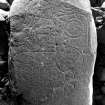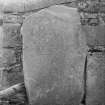Pricing Change
New pricing for orders of material from this site will come into place shortly. Charges for supply of digital images, digitisation on demand, prints and licensing will be altered.
Rhynie, St Luag's Church, Churchyard, Rhynie No. 5
Pictish Symbol Stone (Pictish)
Site Name Rhynie, St Luag's Church, Churchyard, Rhynie No. 5
Classification Pictish Symbol Stone (Pictish)
Canmore ID 17194
Site Number NJ42NE 32.02
NGR NJ 49955 26512
NGR Description Removed from NJ 4992 2649
Datum OSGB36 - NGR
Permalink http://canmore.org.uk/site/17194
- Council Aberdeenshire
- Parish Rhynie
- Former Region Grampian
- Former District Gordon
- Former County Aberdeenshire
Rhynie 5, Aberdeenshire, Pictish symbol stone
Measurements: H 1.63m (ECMS), W 0.76m, D 0.23m
Stone type: whinstone
Place of discovery: NJ 4992 2649
Present location: in a wooden shelter in the kirkyard car-park.
Evidence for discovery: found re-used in the foundations of the old church during demolition in 1878.
Present condition: weathered and top right-hand corner is damaged.
Description
One broad face of this slab bears three incised symbols: the beast’s head and the double disc and Z-rod above a mirror and comb. The surviving terminal of the z-rod is simplified, the mirror has a double-disc shaped handle and the comb is single-sided.
Date: seventh century.
References: ECMS pt 3, 183-4, no 5; Fraser 2008, no 43.5.
Desk-based information compiled by A Ritchie 2017
Field Visit (3 October 1967)
Two Pictish symbol stones, as described and illustrated, both situated at the entrance to the graveyard at NJ 4995 2651.
Surveyed at 1/2500.
Visited by OS (NKB) 3 October 1967
Desk Based Assessment (1967)
NJ42NE 30 49955 26512 (removed from NJ 4992 2649)
(NJ 4992 2649). Two sculptured stones were dug up amongst a number of other large stones from the foundations of the old church at Rhynie in the summer of 1878. One was used to form the foundation of a gate pillar but was recovered and now stands with the other against the north wall of the old churchyard by the entrance gateway. The whinstone example has a beast's head, double-disc, Z rod, mirror and comb symbols on it and the red granite stone has the double-disc, Z-rod, crescent and V-rod with mirror symbols (No. 5 and 6 respectively).
C Maclagan 1880; J R Allen and J Anderson 1903.
Two early Pictish stones, the larger, of gabbro, incised with a fine beast's head (resembling an otter or seal), a double disc and Z-rod and a mirror and comb. The comb is of a particular type which may be as early as the 4th or 5th century, while the surviving terminal of the Z-rod is more usually found on certain V-rods. The small slab of pink granite has part of an incised double disc and Z-rod, a crescent and V-rod, and a mirror, all in a very simple style.
A total of eight Pictish symbol stones comes from the immediate vicinity of the churchyard, perhaps focussed on the Craw Stane (NJ42NE 35).
I A G Shepherd 1986.
Information from OS.
Reference (1986)
Two early Pictish stones, the larger, of gabbro, incised with a fine beast's head (resembling an otter or seal), a double disc and Z-rod and a mirror and comb. The comb is of a particular type which may be as early as the 4th or 5th century, while the surviving terminal of the Z-rod is more usually found on certain V-rods. The small slab of pink granite has part of an incised double disc and Z-rod, a crescent and V-rod, and a mirror, all in a very simple style.
A total of eight Pictish symbol stones comes from the immediate vicinity of the churchyard, perhaps focussed on the Craw Stane (NJ42NE 35).
I A G Shepherd 1986.
Reference (1994)
Originally found at NJ 4992 2649, these stones are now at the entrance to the graveyard (NJ 4995 2649).
RCAHMS 1994.
Publication Account (1996)
Three early Pictish stones, the largest, of gabbro, incised with a fine beast's head (resembling an otter or seal), a double disc and Z-rod and a mirror and comb. The comb is of a particular type which may be as early as the 4th or 5th century, while the surviving terminal of the Z-rod is more usually found on certain V-rods.
The slab of pink granite has part of an incised double disc and Z-rod, a crescent and V-rod and a mirror, all in a very simple style. The smallest stone, which has been cut down from a larger slab, bears a lightly-incised beast, a distinctive comb, and a curvilinear symbol.
A total of eight Pictish stones comes from the immediate vicinity of the kirkyard, perhaps focused on the Craw Stane, a substantial slab incised with a fish and a beast, which still stands on the hill shoulder above (NJ 497263).
Two stones now stand in the village square, but are almost illegible, barring the spear carried by one figure. A cast of the Rhynie Man, a fierce male figure, 1.07m tall and carved on a heavy boulder, bearing an axe, may be seen in the entrance to Rhynie School; the original is on display in the foyer of Woodhill House, Westburn Road, Aberdeen (NJ 911069) (open Monday-Friday).
Information from ‘Exploring Scotland’s Heritage: Aberdeen and North-East Scotland’, (1996).
Reference (1997)
Rhynie 5 : shows a dog's head with to the right a double-disc and Z-rod which is above a mirror-and-comb.
A Mack 1997.
Note (May 2017)
Discovering a Lost People
Modern day Rhynie is a rural village in central Aberdeenshire, surrounded by open countryside. It is a picturesque location, and deceptively modest, for archaeological evidence attests to many centuries of high status settlement in the area. Even the name Rhynie itself is regal, deriving from 'Rig' meaning King. Many Pictish stones have been found here, including the famous 'Rhynie Man', a 6ft high figure carrying an axe, found in a field in 1978.
So who were the Picts, and what were they doing at Rhynie? These are the very questions which are currently being investigated by The University of Aberdeen's Northern Picts project. The project aims to find the Picts in the landscape of Northern Scotland, and has had many notable successes in recent years. The Rhynie Environs Archaeology Project (REAP) is a key case study within the Northern Picts project. It is a collaborative endeavor between the Universities of Aberdeen, Chester and Glasgow and the local community artist collective Rhynie Woman.
Excavations in 2011 and 2012 revealed a series of fortified enclosures near to the the Craw Stane, a Class I Pictish symbol stone which still stands today. This is located at Barflat, northwest of the present day village and very close to where Rhynie Man was found in the 1970s. Early indications were that this was an important settlement. Further work revealed a series of concentric enclosures centred on a ring ditch and other possible timber structures, and in association with the Class I symbol stone. An interpretative reconstruction of the site has recently been completed and it is available to view online. You can access it by clicking on the link below.
Settlement evidence for this period is very rare, and the evidence for Pictish buildings which has been found at Rhynie is extremely important. Equally significant is the evidence for large-scale high status metalworking at the site, and a range of Continental imports which have been found here, indicating without doubt that Rhynie was an important power centre dating from the 4th to the 6th centuries AD. A contemporary cemetery has been found closer to the village.
Contextualising Rhynie / Moulds and Metal
The Rhynie Environs Archaeology Project is investigating the interaction between the high status site here and the wider landscape. The complex at Barflat is close to two small fortified sites at Cairnmore and Wheedlemont, and the great hillfort at Tap O'Noth [see previous Archaeology InSites feature under Age of Iron]. A 5th/6th century phase has been identified at Cairnmore and it is very likely that both Wheedlemont and Tap were in use at this time, but connections between these sites and Rhynie are still to be established. Understanding the links between these sites, and indeed if they are there at all, is key to understanding the development and control of the landscape of the Strathbogie area.
Rhynie has yielded a rich assemblage of high status material. One of the most iconic finds from the site is the axe shaped pin which was found in 2012. This pin, with its serpent design, resembles the axe which is carried by Rhynie Man, now in the reception area of Woodhill House, the headquarters of Aberdeenshire Council. The 2016 excavations revealed the best evidence yet for high status metalworking at Rhynie. Over 50 sherds of crucibles were found at the site, and clay moulds were uncovered in greater numbers than at any other known Pictish site. These moulds produced a range of different pins and brooches. There was even evidence for enameling. The finds from the 2016 season are currently undergoing conservation work, and although less visually striking than the finished products, they have the potential to tell us far more.
Dr Kirsty Owen - Archaeology and World Heritage Team






































